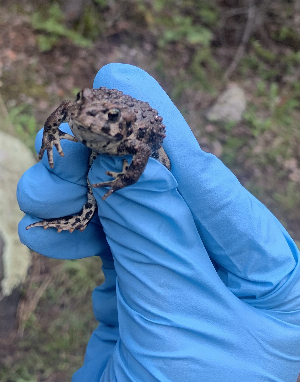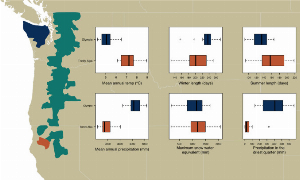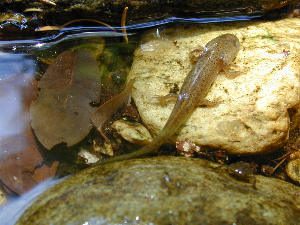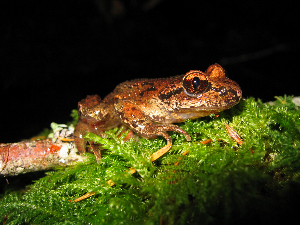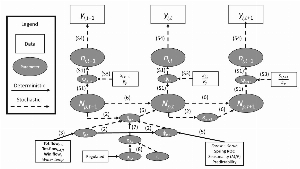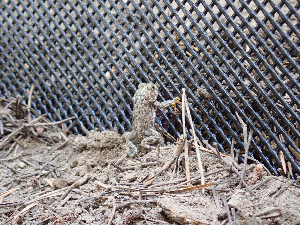Search ARMI Database
Search term(s)
Contribution Number
Search Results
856 record(s) found.
Papers & Reports Of toads and tolerance: Quantifying intraspecific variation in host resistance and tolerance to a lethal pathogen
Authors: Bennett Hardy; Erin Muths; W C Funk; Larissa L Bailey
Date: 2024-05-30 | Outlet: Journal of Animal Ecology
Due to the ubiquity of disease in natural systems, hosts have evolved strategies of disease resistance and tolerance to defend themselves from further harm once infected. Resistance strategies directly limit pathogen growth, typically leading to lower infection burdens in the host. A tolerance approach limits the fitness consequences caused by the pathogen but does not directly inhibit pathogen growth. Testing for intraspecific variation in wild host populations is important for informing conservation decisions about captive breeding, translocation, and disease treatment. Here, we test for the relative importance of tolerance and resistance in multiple populations of boreal toads (Anaxyrus boreas boreas) against Batrachochytrium dendrobatidis (Bd), the amphibian fungal pathogen responsible for the greatest host biodiversity loss due to disease. Boreal toads have severely declined in Colorado (CO) due to Bd, but toad populations challenged with Bd in western Wyoming (WY) appear to be less affected. We used a common garden infection experiment to expose post-metamorphic toads sourced from four populations (2 in CO and 2 in WY) to Bd and monitored changes in mass, pathogen burden, and survival for eight weeks. We used a multi-state modeling approach to estimate weekly survival and transition probabilities between infected and cleared states, reflecting a dynamic infection process that traditional approaches fail to capture. We found that WY boreal toads are highly tolerant to Bd infection with higher survival probabilities than those in CO when infected with identical pathogen burdens. WY toads also had higher probabilities of clearing infections and took an average of five days longer to reach peak infection burdens. Our results demonstrate strong intraspecific differences in tolerance and resistance that explain why population declines vary regionally across the species. We used a robust, multi-state framework to gain inference on typically hidden disease processes when testing for host tolerance or resistance and demonstrated that describing an entire species as ‘tolerant’ or ‘resistant’ is unwise without testing for intraspecific variation in host defenses.
Papers & Reports Matching decision support modeling frameworks to disease emergence stages
Authors: Evan HC Grant; Brittany A Mosher; Riley F Bernard; Alexander D Wright; Robin E Russell
Wildlife disease management decisions often require rapid responses to situations that are fraught with uncertainty. By recognizing that management is implemented to achieve specific objectives (whether defined explicitly or not), resource managers and science partners can identify an analysis technique and develop a plan to collect necessary data that will allow for the evaluation of management actions.
Papers & Reports Preparing for a Bsal invasion into North America has improved multi-sector readiness
Authors: Deanna H Olson; Evan HC Grant; Molly Bletz; Jonah Piovia-Scott; Jacob L Kerby; Michael J Adams; Florencia M Breitman; Michelle R Christman; María J Forzán; Matthew J Gray; Aubree J Hill; M S Koo; David Lesbarrères; Olga Milenkaya; Eria A Rebollar; Louise A Rollins-Smith; Megan Serr; Alex Shepak; Lenny Shirose; L Sprague; Jenifer Walke; Alexa R Warwick; Brittany A Mosher
Western palearctic salamander susceptibility to the skin disease caused by the amphibian chytrid fungus Batrachochytrium salamandrivorans (Bsal) was recognized in 2014, eliciting concerns for a potential novel wave of amphibian declines following the B. dendrobatidis (Bd) chytridiomycosis global pandemic. Although Bsal had not been detected in North America, initial experimental trials supported the heightened susceptibility of caudate amphibians to Bsal chytridiomycosis.
Papers & Reports Contrasting demographic responses under future climate at multiple life stages for two populations of a montane amphibian
Authors: Amanda M Kissel; Wendy J Palen; Michael J Adams; Justin Garwood
Date: 2024-01-03 | Outlet: Climate Change Ecology
For species with complex life histories, climate change can have contrasting effects for different life stages within locally adapted populations and may result in responses counter to general climate change predictions. Using data from two, 14-year demographic studies for a North American montane amphibian, Cascades frog (Rana cascadae), we quantified how aspects of current climate influenced annual survival of larvae and adult stages and modeled the stochastic population growth rate (?s) of each population for current (1980-2006) and future periods (2080s). Climate drivers of survival for the populations were similar for larvae (i.e. decreases in precipitation lead to pond drying and mortality), but diverged for terrestrial stages where decreases in winter length and summer precipitation had opposite effects. By the 2080s, we predict one population will be in sharp decline (?s = 0.90),while the other population will remain nearly stable (?s = 0.99) in the absence of other stressors, such as mortality due to disease. Our case study demonstrates a result counter to many climate envelope predictions in that stage-specific responses to local climate and hydrology result in a higher extinction risk for the more northern population.
Papers & Reports Terrestrial Movement Patterns of the Common Toad (Bufo bufo) in Central Spain Reveal Habitat of Conservation Importance
Authors: David R Daversa; Erin Muths; Jaime Bosch
Date: 2012 | Outlet: Journal of Herpetology, 46(4):658-664
Journal of Herpetology, 46(4):658-664
Papers & Reports Native amphibian toxin reduces invasive crayfish feeding with potential benefits to stream biodiversity
Authors: Gary Bucciarelli; Sierra J. Smith; Justin J. Choe; Phoebe D. Shin; Robert N Fisher; Lee B Kats
Date: 2023-09-13 | Outlet: BMC Ecology and Evolution 23, 51
Biodiversity is generally reduced when non-native species invade an ecosystem. Invasive crayfish, Procambarus clarkii, populate California freshwater streams, and in the Santa Monica Mountains (Los Angeles, USA), their introduction has led to trophic cascades due to omnivorous feeding behavior and a rapid rate of population growth. The native California newt, Taricha torosa, possesses a neurotoxin, tetrodotoxin (TTX), that affects freshwater animal behavior. Given P. clarkii has a limited evolutionary history with TTX, we hypothesized that TTX may affect crayfish feeding behaviors. To determine if TTX affects P. clarkii behavior, we measured cumulative movement and various feeding behaviors of P. clarkii exposed to (i) waterborne, ecologically realistic concentrations of TTX (~?3.0?×?10??8 moles/L), (ii) an anuran chemical cue to account for intraguild cues, or (iii) a T. torosa chemical cue with quantitated TTX in it (~?6.2?×?10??8 moles/L).
Results
We found that the presence of TTX in any form significantly reduced crayfish movement and decreased the amount of food consumed over time. Crayfish responses to the anuran treatment did not significantly differ from controls.
Conclusion
Our laboratory results show that naturally occurring neurotoxin from native California newts limits invasive crayfish foraging and feeding rates, which may play a role in preserving local stream ecosystems by limiting invasive crayfish behaviors that are detrimental to biodiversity.
Results
We found that the presence of TTX in any form significantly reduced crayfish movement and decreased the amount of food consumed over time. Crayfish responses to the anuran treatment did not significantly differ from controls.
Conclusion
Our laboratory results show that naturally occurring neurotoxin from native California newts limits invasive crayfish foraging and feeding rates, which may play a role in preserving local stream ecosystems by limiting invasive crayfish behaviors that are detrimental to biodiversity.
Papers & Reports BioLake: A first assessment of lake temperature-derived bioclimatic predictors for aquatic invasive species
Authors: Ryan C Burner; Wesley M. Daniel; Peder S. Engelstad; Christopher J. Churchill; Richard E Erickson
Date: 2023-07-10 | Outlet: Ecosphere 14(7):e4616
Aquatic invasive species (AIS) present major ecological and economic challenges globally, endangering ecosystems and human livelihoods. Managers and policy makers thus need tools to predict invasion risk and prioritize species and areas of concern, and they often use native range climate matching to determine whether a species could persist in a new location. However, climate matching for AIS often relies on air temperature rather than water temperature due to a lack of global water temperature data layers, and predictive power of models is seldom evaluated. We developed 12 global lake (water) temperature-derived “BioLake” bioclimatic layers for distribution modeling of aquatic species and compared “climatch” climate matching predictions (from climatchR package) from BioLake with those based on BioClim temperature layers and with a null model. We did this for 73 established AIS in the United States, training the models on their ranges outside of the United States and Canada. Models using either set of climate layers outperformed the null expectation by a similar (but modest) amount on average, but some species were occasionally found in locations with low climatch scores. Mean US climatch scores were higher for most species when using air temperature. Including additional climate layers in models reduced mean climatch scores, indicating that commonly used climatch score thresholds are not absolute but can be context specific and may require calibration based upon climate data used. Although finer resolution global lake temperature data would likely improve predictions, our BioLake layers provide a starting point for aquatic species distribution modeling. Climate matching was most effective for some species that originated at low latitudes or had small ranges. Climatch scores remain useful but limited for predicting AIS risk, perhaps because current ranges seldom fully reflect climatic tolerances (fundamental niches). Managers could consider climate matching as one of a suite of tools that can be used in AIS prioritization.
Papers & Reports Critical review of the phytohemagglutinin assay for assessing amphibian immunity
Authors: Lauren Hawley; Kelly L Smalling; Scott Glaberman
Date: 2023-12-12 | Outlet: Conservation Physiology
Infectious diseases are a major driver of the global amphibian decline. In addition, many factors, from genetics and stress to pollution and climate change, can influence the response to pathogens. Therefore, it is important to be able to evaluate amphibian immunity in the field and in the laboratory. The phytohemagglutinin (PHA) assay is an inexpensive and relatively non-invasive tool that has been used extensively to assess immunocompetence, especially in birds, and more recently in amphibians. However, there is substantial variation in experimental methodology among amphibian PHA studies in terms of species and life stages, PHA doses and injection sites, and use of experimental controls. Here, we compile and compare all known PHA studies in amphibians in order to identify knowledge gaps and develop best practices for future work. We found that research has only been conducted on a limited number of species, which may not reflect the diversity of amphibians as a whole. There is also a lack of validation studies in most species, so that doses and timing of PHA injection and subsequent swelling measurements may not effectively evaluate immunocompetence. Based on these and other findings, we put forward a set of recommendations to make future PHA studies more consistent and improve the ability to utilize this assay in wild populations, where immune surveillance is greatly needed.
Papers & Reports Geographic Distribution. Storeria occipitomaculata
Authors: Aidan G Phillips; William C Carroll; Brad M Glorioso
Date: 2022-12-01 | Outlet: Herpetological Review
Geographic distribution parish record for this snake species
Papers & Reports Thirteen Years of Turtle Capture-Mark-Recapture in a Small Urban Pond Complex in Louisiana, USA
Authors: Brad M Glorioso; Hardin J Waddle; Doug P Armstrong
Date: 2023-09 | Outlet: Journal of Herpetology
Turtles are one of the most imperiled vertebrate groups in the world. With habitat destruction unabated in many places, urban and suburban greenspaces may serve as refugia for turtles, at least those species able to tolerate heavily altered landscapes. In south-central Louisiana, we have conducted a turtle capture-mark-recapture effort in two ponds in an urban greenspace for 13 years to understand species composition, survival, and individual growth rates. We had 574 total captures of 251 individuals of five species from 2009–2021, with Trachemys scripta elegans (Red-eared Sliders) and Sternotherus odoratus (Eastern Musk Turtles) being most common. Apparent annual survival for T. scripta (0.79) was similar to estimates reported in other studies in altered habitats, whereas apparent annual survival for S. odoratus (0.89) was slightly or much higher than other published studies. Growth rates of T. scripta were comparable to other studies and showed both sexes have similar rates of growth until maturity, which is earlier and at a smaller size in males. The two ponds showed marked differences in captures by size, with significantly more juvenile T. scripta captured in the pond with more vegetation, depth, and a softer bottom. Most T. scripta (78.5%) that were recaptured came from the same pond they were originally captured. The basic demographic data gained in this study can serve as a starting point for broader questions on urbanization effects and as a comparison to more natural populations.
Papers & Reports A Dataset of Amphibian Species in U.S. National Parks
Authors: Benjamin Lafrance; Andrew M Ray; Robert N Fisher; Evan HC Grant; S F Spear; J M Davenport; Brad M Glorioso; William J Barichivich; Brian J Halstead; Blake R Hossack
Date: 2024-01 | Outlet: Scientific Data 11: 21
National parks and other protected areas are important for preserving landscapes and biodiversity worldwide. An essential component of the mission of the United States (U.S.) National Park Service (NPS) requires understanding and maintaining accurate inventories of species on protected lands. We describe a new, national-scale synthesis of amphibian species occurrence in the NPS system. Many park units have a list of amphibian species observed within their borders compiled from various sources and available publicly through the NPSpecies platform. However, many of the observations in NPSpecies remain unverified and the lists are often outdated. We updated the amphibian dataset for each park unit by collating old and new park-level records and had them verified by regional experts. The new dataset contains occurrence records for 292 of the 424 NPS units and includes updated taxonomy, international and state conservation rankings, hyperlinks to a supporting reference for each record, specific notes, and related fields which can be used to better understand and manage amphibian biodiversity within a single park or group of parks.
Papers & Reports Adjacent and downstream effects of forest harvest on the distribution and abundance of larval headwater stream amphibians in the Oregon Coast Range
Authors: Adam Duarte; Nathan D Chelgren; Jennifer C Rowe; Christopher A Pearl; Sherri L. Johnson; Michael J Adams
Date: 2023-07-21 | Outlet: Forest Ecology and Management
Forest harvest is a primary landscape-scale management action affecting riparian forests. Although concerns about impacts of forest harvest on stream amphibians is generally limited to areas adjacent to harvest, there is a paucity of information regarding potential downstream effects of forest harvest on these species. We designed a before-after, control-impact (BACI) experiment to quantify potential impacts of clearcut logging that included 12-m buffers or smaller variable-width buffers on the distribution and abundance of headwater stream amphibians in adjacent and downstream areas. We sampled larval coastal tailed frogs (Ascaphus truei), coastal giant salamanders (Dicamptodon tenebrosus), and Columbia torrent salamanders (Rhyacotriton kezeri) across 3,915 sampling occasions that spanned 13 study reaches in 2008–2011 (pre-harvest) and 2013–2016 (post-harvest) as part of the Trask River Watershed Study in the Oregon Coast Range, U.S.A. We analyzed these data using occupancy models to estimate occupancy and (when possible) relative abundance, while accounting for various sources of imperfect detection. All species exhibited reduced occupancy adjacent to clearcuts with variable-width buffers (odds ratios [ORs] ranged = 0.24–0.48), and these negative impacts were not always diminished when increasing the buffer size to 12 m (ORs ranged = 0.20–3.56). Dicamptodon tenebrosus was the only species to have occupancy impacted in downstream areas, and this negative impact was related to clearcut logging with uniform 12-m buffers (OR = 0.60). This species was also the only species to have abundance negatively impacted by forest harvest in downstream areas (OR = https://0.41 with uniform 12-m buffers, OR = https://0.38 with variable-width buffers), albeit impacts to abundance were not evaluated for R. kezeri. Ascaphus truei abundance increased in areas downstream of clearcut logging with uniform 12-m buffers (OR = 2.92). Although we found the direction and magnitude of responses varied by species, our study confirms that clearcut logging can have negative impacts on amphibians that inhabit the adjacent stream areas. Perhaps more importantly, we also found that forest harvest can have negative effects on stream amphibians downstream of the harvested area and that increasing the buffer size to 12 m did not necessarily diminish these impacts in adjacent and downstream areas. Altogether, our study provides a nuanced picture of adjacent and downstream effects of forest harvest on three endemic headwater stream amphibians, and our findings demonstrate that forest management practices should consider downstream effects on aquatic taxa when assessing the impact of harvesting trees near headwater streams.
Papers & Reports Identifying drivers of population dynamics for a stream breeding amphibian using time series of egg mass counts
Authors: Jonathan P Rose; Sarah J Kupferberg; Ryan A Peek; Don Ashton; James B Bettaso; Steven Bobzien; Ryan M Bourque; Koen GH Breedveld; Alessandro Catenazzi; Joseph E Drennan; Earl Gonsolin; Marcia Grefsrud; Andrea E Herman; Matthew R House; Matt R Kluber; A J Lind; Karla R Marlow; Alan Striegle; Michael G van Hattem; Clara A Wheeler; Jeffery T Wilcox; Kevin D Wiseman; Brian J Halstead
Date: 2023-08-24 | Outlet: Ecosphere: Volume14, Issue 8
The decline of amphibian populations is one of the starkest examples of the biodiversity crisis. For stream-breeding amphibians, alteration of natural flow regimes by dams, water diversions, and climate change have been implicated in declines and extirpations. Identifying drivers of amphibian declines requires long time series of abundance data because amphibian populations can exhibit high natural variability. Multiple population viability analysis (MPVA) models integrate abundance data and share information from different populations to estimate how environmental factors influence population growth. Flow alteration has been linked to declines and extirpations in the Foothill Yellow-Legged Frog (Rana boylii), a stream-breeding amphibian native to California and Oregon. To date, no study has jointly analyzed abundance data from populations throughout the range of R. boylii in an MPVA model. We compiled time series of egg mass counts (an index of adult female abundance) from R. boylii populations in 36 focal streams and fit an MPVA model to quantify how streamflow metrics, stream temperature, and surrounding land cover affect population growth. We found population growth was positively related to stream temperature and was higher in the years following a wet year with high total annual streamflow. Density-dependence was weakest (i.e., carrying capacity was highest) for streams with high seasonality of streamflow and intermediate rates of change in streamflow during the spring. Our results highlight how altered streamflow can further increase the risk of decline for R. boylii populations. Managing stream conditions to better match natural flow and thermal regimes would benefit the conservation of R. boylii populations.
Papers & Reports Broad-scale Assessment of Methylmercury in Adult Amphibians
Authors: Brian J Tornabene; Blake R Hossack; Brian J Halstead; Collin A Eagles-Smith; Michael J Adams; Adam R Backlin; Adrianne B Brand; Colleen S Emery; Robert N Fisher; Jill Fleming; Brad M Glorioso; Daniel A Grear; Evan HC Grant; Patrick M Kleeman; David AW Miller; Erin Muths; Christopher A Pearl; Jennifer C Rowe; Caitlin T Rumrill; Hardin J Waddle; Megan E Winzeler; Kelly L Smalling
Date: 2023-10-30 | Outlet: Environmental Science & Technology
Mercury (Hg) is a toxic contaminant that has been mobilized and distributed worldwide and is a threat to many wildlife species. Amphibians are facing unprecedented global declines due to many threats, including contaminants. While the bi-phasic life history of many amphibians creates a potential nexus for methylmercury (MeHg) exposure in aquatic habitats and subsequent health effects, the broad-scale distribution of MeHg exposure in amphibians remains unknown. We used non-lethal sampling to assess MeHg bioaccumulation in 3,241 juvenile and adult amphibians during 2017–2021. We sampled 26 populations (14 species) across 11 states in the United States, including several imperiled species that could not have been sampled by traditional lethal methods. We examined whether life history traits of species and whether concentration of total mercury in sediment or dragonflies could be used as indicators of MeHg bioaccumulation in amphibians. Methylmercury contamination was widespread, with a 33-fold difference in concentrations across sites. Variation among years and clustered subsites was less than variation across sites. Life history characteristics such as size, sex, and whether the amphibian was a frog, toad, newt, or other salamander were the factors most strongly associated with bioaccumulation. Total Hg in dragonflies was a reliable indicator of bioaccumulation of MeHg in amphibians (R2 ? 0.67) whereas total Hg in sediment was not (R2 ? 0.04). Our study, the largest broadscale assessment of MeHg bioaccumulation in amphibians, highlights methodological advances that allow for non-lethal sampling of rare species and reveals immense variation among species, life histories, and sites. Our findings can help identify sensitive populations and provide environmentally relevant concentrations for future studies to better quantify potential threats of MeHg to amphibians.
Papers & Reports Assay validation of saliva glucocorticoids in Columbia Spotted Frogs and effects of handling and marking
Authors: Brian J Tornabene; Blake R Hossack; Creagh W Breuner
Date: 2023-10-13 | Outlet: Conservation Physiology: Toolbox
Non-invasive methods are important to conservation physiology to reduce negative effects on the species being studied. Glucocorticoid (GC) hormones are often used to assess health of individuals, but collection methods can be invasive. Many amphibians are imperiled worldwide, and saliva is a non- or semi-invasive matrix to measure GCs that has been partially validated for only four amphibian species. Validation ensures that assays are reliable and can detect changes in saliva corticosterone (sCORT) following exposure to stressors, but it is also necessary to ensure sCORT concentrations are correlated with plasma concentrations. To help validate the use of saliva in assessing CORT responses in amphibians, we captured uniquely marked Columbia Spotted Frogs (Rana luteiventris) on sequential days and collected baseline and stress-induced (after handling) samples. For a subset of individuals, we collected and quantified CORT in both saliva and blood samples, which have not been compared for amphibians. We tested several aspects of CORT responses and, by collecting across separate days, measured repeatability of CORT responses across days. We also evaluated whether methods common to amphibian conservation, such as handling alone or handling, clipping a toe, and tagging elevated sCORT. Similar to previous studies, we show that sCORT is reliable concerning parallelism, recovery, precision, and sensitivity. Saliva CORT was weakly correlated with plasma CORT (R2 = 0.21), and we detected elevations in sCORT after handling, demonstrating biological validation. Toe-clipping and tagging did not increase sCORT over handling alone, but repeated handling elevated sCORT for ~72 hours. However, sCORT responses were highly variable and repeatability was low within individuals and among capture sessions, contrary to previous studies with urinary and waterborne CORT. Saliva CORT is a semi-invasive and rapid technique that could be useful to assess effects of anthropogenic change, and conservation efforts, but will require careful study design and future validation.
Papers & Reports Successful eradication of invasive American bullfrogs leads to co-extirpation of emerging pathogens
Authors: Blake R Hossack; D Hall; C L Crawford; Caren S Goldberg; Erin Muths; Brent H Sigafus; Thierry C Chambert
Date: 2023 | Outlet: Conservation Letters
Interventions of host-pathogen dynamics provide strong tests of relationships, yet they are still rarely applied across multiple populations. After American Bullfrogs (Rana catesbeiana) invaded a wildlife refuge where federally threatened Chiricahua Leopard Frogs (R. chiricahuensis) were reintroduced 12 years prior, managers launched a landscape-scale eradication effort to help ensure continued recovery of the native species. We used a before-after-control-impact (BACI) design and environmental DNA sampling of 19 eradication sites and 18 control sites between fall 2016 and winter 2020–2021 to measure community-level responses to bullfrog eradication, including for 2 pathogens. Dynamic occupancy models revealed successful eradication from 94% of treatment sites. Native amphibians did not respond to bullfrog eradication, but the pathogens amphibian chytrid fungus (Batrachochytrium dendrobatidis) and ranaviruses were co-extirpated with bullfrogs. Our spatially replicated experimental approach provides strong evidence that management of invasive species can simultaneously reduce predation and disease risk for imperiled species.
Papers & Reports Prioritizing the risk and management of introduced species in a landscape with high indigenous biodiversity
Authors: Jonathan Q Richmond; Jennifer Kingston; Brittany Ewing; Wendy Bear; Stacie A Hathaway; Cedric Lee; Camm C. Swift; Kristine L Preston; Allison J Schultz; Barbara E. Kus; Kerwin Russel; Philip Unitt; B Hollingsworth; Robert E Espinoza; Michael Wall; S Tremor; Kai Palenscar; Robert N Fisher
Date: 2023 | Outlet: Bulletin of the Southern California Academy of Sciences
Risk analysis protocols for prioritizing the management of non-native species are numerous, yet few incorporate risk and management in the same analysis or accommodate a broad diversity of taxa outside of a specific geographic area. We adapted a protocol that accounts for these factors to address non-native animal species in the Southern California/Northern Baja California Coast Ecoregion near the international border in San Diego County, an area with high indigenous biodiversity and high numbers of species of conservation concern. This stepwise, semi-quantitative protocol is applicable to any animal group in any predefined geographic area, relies on consensus-building among taxonomic experts, and has been vetted through previous use and in peer-reviewed literature. Our results show that the final prioritization was driven mainly by management feasibility, with top-ranked species having multitrophic effects that favor other non-native invaders over native residents. Conditions within the assessment area required some modification to the protocol as it was originally designed, namely a shift in emphasis from eradication to control, given that eradication is implausible for most non-native species in the assessment area. We call attention to taxon-specific issues that surfaced during the analysis, identify areas for improvement in this first-ever risk assessment for invasive animal species in the Natural Communities Conservation Plan/Habitat Conservation Plan (NCCP/HCP) reserve system of San Diego County, and provide suggestions for further refinement of the protocol. This study builds on the effort to standardize risk analysis for invasive species globally, given that many of the same invaders present threats to indigenous biodiversity worldwide.
Papers & Reports Elevated road segment (ERS) passage design may provide enhanced connectivity for amphibians, reptiles, and small mammals
Authors: Cheryl S Brehme; Stephanie Barnes; Brittany Ewing; Philip Gould; Cassie Vaughan; Michael Hobbs; Charles Tornaci; Sarah Holm; Hanna Sheldon; Jon Fiutak; Robert N Fisher
Date: 2023-05-24 | Outlet: Frontiers in Ecology and Evolution 11:1145322
Introduction: Designs for safe and effective road crossing structures for small animals are typically under-road microtunnels and culverts which have varying levels of effectiveness reported in the scientific literature. Many species, particularly migratory amphibians, may have limited ability to find and use passages if they are too far apart, resulting in substantial barrier effects.
Methods: We designed a novel open elevated passage (elevated road segment: ERS), similar to a low terrestrial bridge, that could theoretically be built to any length based upon species needs and movement characteristics. A 30 m length prototype ERS was installed along a forest road with a history of amphibian road mortality in Sierra National Forest, Fresno County, CA, USA. From 2018 to 2021, we monitored small animal activity under the ERS in relation to surrounding roadside and forest habitats using active infrared cameras.
Results: We documented a total of 8,815 unique use events, using species specific independence criteria, across 22 species of amphibians (3), reptiles (4), and small mammals (15). Poisson regression modeling of taxonomic group activity under the ERS, roadside and forest, showed that amphibian activity was highest in the forest habitat, no differences were observed for reptiles, and small mammal activity was highest under the ERS. However, mean activity estimates under the ERS were equal to or greater than the open roadside habitat for all 22 species, suggesting that adding cover objects, such as downed logs and vegetation may further enhance passage use.
Discussion: Overall, results showed that the design of the ERS crossing has potential to provide high connectivity for a wide range of amphibian, reptile, and small mammal species while reducing road mortality. ERS systems can also be used in areas with challenging terrain and other hydrological and environmental constraints. Incorporating current road ecology science, we provide supplemental ERS concept designs for secondary roads, primary roads and highways to help increase the options available for road mitigation planning for small animals.
Methods: We designed a novel open elevated passage (elevated road segment: ERS), similar to a low terrestrial bridge, that could theoretically be built to any length based upon species needs and movement characteristics. A 30 m length prototype ERS was installed along a forest road with a history of amphibian road mortality in Sierra National Forest, Fresno County, CA, USA. From 2018 to 2021, we monitored small animal activity under the ERS in relation to surrounding roadside and forest habitats using active infrared cameras.
Results: We documented a total of 8,815 unique use events, using species specific independence criteria, across 22 species of amphibians (3), reptiles (4), and small mammals (15). Poisson regression modeling of taxonomic group activity under the ERS, roadside and forest, showed that amphibian activity was highest in the forest habitat, no differences were observed for reptiles, and small mammal activity was highest under the ERS. However, mean activity estimates under the ERS were equal to or greater than the open roadside habitat for all 22 species, suggesting that adding cover objects, such as downed logs and vegetation may further enhance passage use.
Discussion: Overall, results showed that the design of the ERS crossing has potential to provide high connectivity for a wide range of amphibian, reptile, and small mammal species while reducing road mortality. ERS systems can also be used in areas with challenging terrain and other hydrological and environmental constraints. Incorporating current road ecology science, we provide supplemental ERS concept designs for secondary roads, primary roads and highways to help increase the options available for road mitigation planning for small animals.
Papers & Reports Inferring pathogen presence when sample misclassification and partial observation occur
Authors: Evan HC Grant; Riley O Mummah; Brittany A Mosher; Jonah Evans; Graziella V DiRenzo
Date: 2023-04-11 | Outlet: Methods in Ecology and Evolution
1. Surveillance programs are essential for detecting emerging pathogens and often rely on molecular methods to make inference about the presence of a target disease agent. However, molecular methods rarely detect target DNA perfectly. For example, molecular pathogen detection methods can result in misclassification (i.e., false positives and false negatives) or partial detection errors (i.e., detections with ‘ambiguous’, ‘uncertain’, or ‘equivocal’ results). Then, when data are to be analyzed, these?partial observations?are?either?discarded?or censored;?this, however, disregards information that could be used to make inference about the true state of the system. There is a critical need for more direction and guidance related to how many samples is enough to declare a unit of interest ‘pathogen-free’.
2. Here, we develop a Bayesian hierarchal framework that accommodates false negative, false positive, and uncertain detections to improve inference related to the occupancy of a pathogen. We apply our modeling framework to a case study of the fungal pathogen Pseudogymnoascus destructans (Pd) identified in Texas bats at the invasion front of white-nose syndrome. To improve future surveillance programs, we provide guidance on sample sizes required to be 95% certain a target organism is absent from a site.
3. We found that the presence of uncertain detections increased the variability of resulting posterior probability distributions of pathogen occurrence, and that our estimates of required sample size were very sensitive to prior information about pathogen occupancy, pathogen prevalence, and diagnostic test specificity. In the Pd case study, we found that the posterior probability of occupancy was very low in 2018, but occupancy probability approached 1 in 2020, reflecting increasing prior probabilities of occupancy and prevalence elicited from the site manager.
4. Our modeling framework provides the user a posterior probability distribution of pathogen occurrence, which allows for subjective interpretation by the decision-maker. To help readers apply and use the methods we developed, we provide an interactive?RShiny?app?that generates target species?occupancy estimation and sample size estimates to make these methods more accessible?to the scientific community (https://rmummah.shinyapps.io/ambigDetect_sampleSize).?This modeling framework and sample size guide may be useful for improving inferences from molecular surveillance data about emerging pathogens, non-native invasive species, and endangered species where misclassifications and ambiguous detections occur.
2. Here, we develop a Bayesian hierarchal framework that accommodates false negative, false positive, and uncertain detections to improve inference related to the occupancy of a pathogen. We apply our modeling framework to a case study of the fungal pathogen Pseudogymnoascus destructans (Pd) identified in Texas bats at the invasion front of white-nose syndrome. To improve future surveillance programs, we provide guidance on sample sizes required to be 95% certain a target organism is absent from a site.
3. We found that the presence of uncertain detections increased the variability of resulting posterior probability distributions of pathogen occurrence, and that our estimates of required sample size were very sensitive to prior information about pathogen occupancy, pathogen prevalence, and diagnostic test specificity. In the Pd case study, we found that the posterior probability of occupancy was very low in 2018, but occupancy probability approached 1 in 2020, reflecting increasing prior probabilities of occupancy and prevalence elicited from the site manager.
4. Our modeling framework provides the user a posterior probability distribution of pathogen occurrence, which allows for subjective interpretation by the decision-maker. To help readers apply and use the methods we developed, we provide an interactive?RShiny?app?that generates target species?occupancy estimation and sample size estimates to make these methods more accessible?to the scientific community (https://rmummah.shinyapps.io/ambigDetect_sampleSize).?This modeling framework and sample size guide may be useful for improving inferences from molecular surveillance data about emerging pathogens, non-native invasive species, and endangered species where misclassifications and ambiguous detections occur.
Papers & Reports By land, air, and water – USGS science supporting fish and wildlife migrations throughout North America
Authors: Mona Khalil; Mark Wimer; David Hu; Michael J Adams; Melanie Steinkamp; Suzanna C Soileau
Date: 2022-06-22
Countless species of animals—big game, birds, bats, insects, amphibians, reptiles, and fish—migrate to reach suitable habitats to feed, reproduce, and raise their young. Animal migrations developed over millennia commonly follow migration corridors—unique routes for each species—to move among seasonal habitats. Changes along those corridors, whether from human development (buildings, roads, dams) or from natural disturbances (for example, climate change, drought, fire, flooding, or invasive species), can make them harder to navigate. The U.S. Geological Survey’s Ecosystems Mission Area provides science that assists land managers in mapping, enhancing, protecting, and reconnecting migration corridors critical for diverse fish and wildlife populations that migrate, such as Odocoileus hemionus (mule deer) and Antilocapra americana (pronghorn), trout and salmon, salamanders, tortoises, bats, and Danaus plexippus (monarch butterflies).

